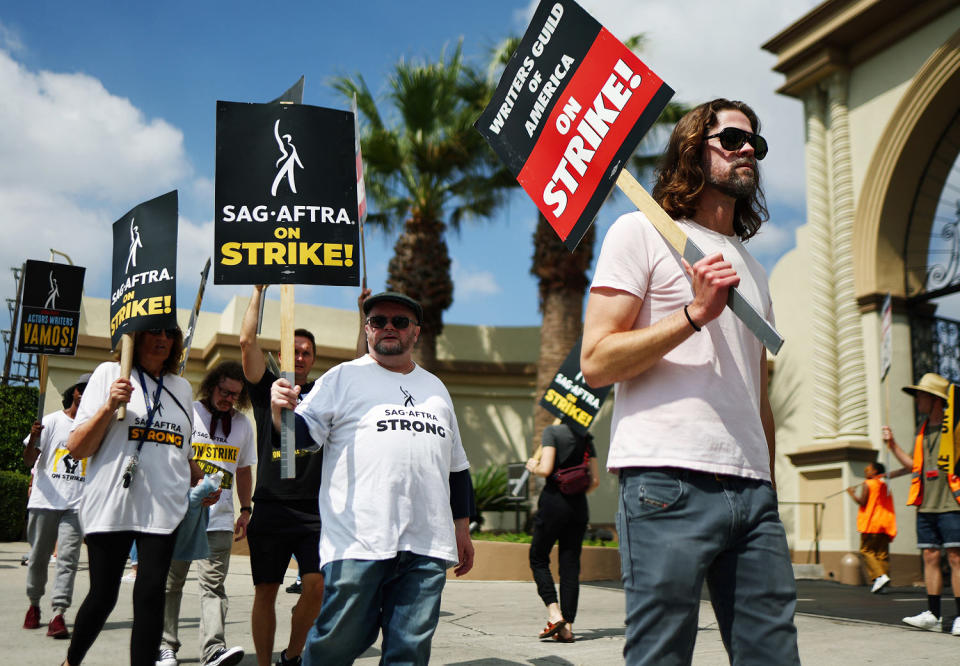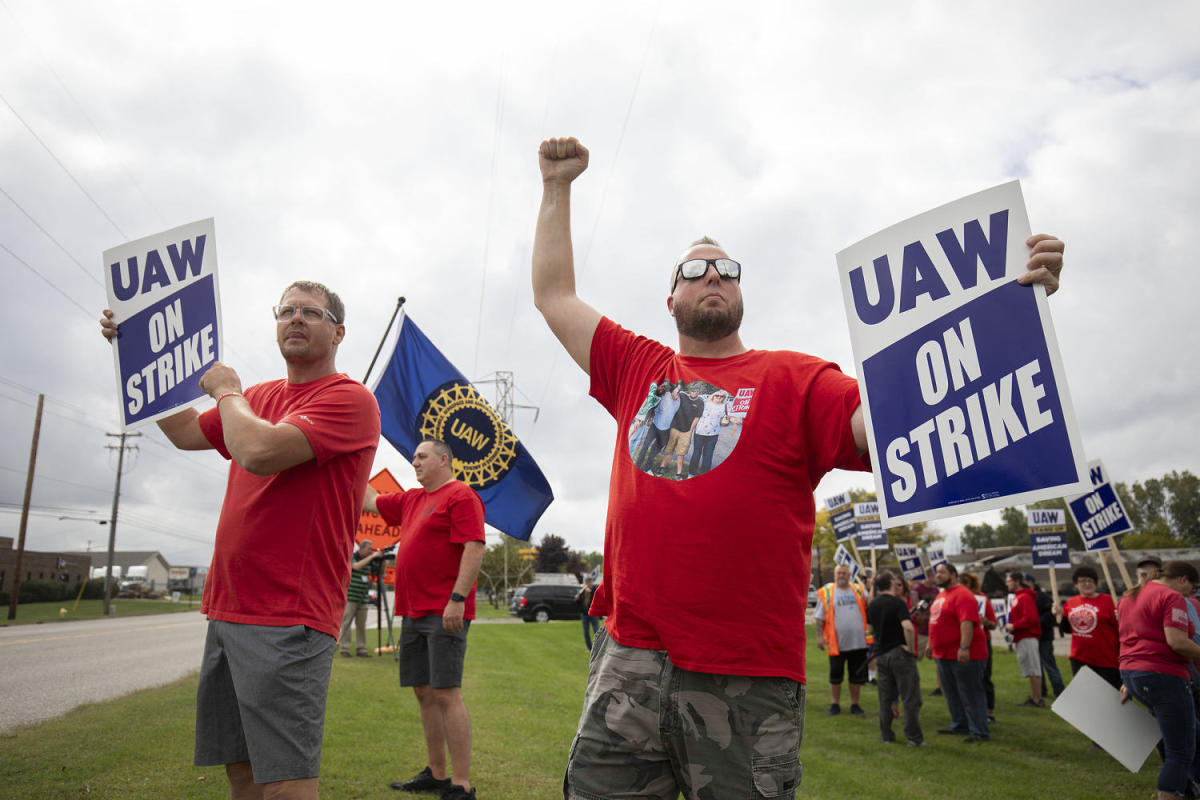Joe Biden’s presidency has seen a flurry of labor actions from Detroit to Hollywood. What comes next could hinge on who gets to oversee labor relations after the election.
The National Labor Relations Board — which polices unfair labor practices and mediates worker-management disputes — has become an aggressive union booster under Biden. While the agency’s policies typically shift depending on who’s in the White House, the change has been pronounced, labor experts and former NLRB staffers say.
“You’d have to go back to the 1930s and early 1940s to see something of this nature,” said Michael LeRoy, a professor at the School of Labor and Employment Relations at the University of Illinois Urbana-Champaign.
But the NLRB’s recent efforts haven’t always succeeded, and emerging court battles will affect whether its more muscular approach — whether on behalf of workers or employers — can continue, as former President Donald Trump and Vice President Kamala Harris vie for union votes.
“The confluence of a strongly pro-labor NLRB and a strongly anti-labor Supreme Court are sort of mixing together to create this atmosphere of instability,” LeRoy said.
A pro-labor push
“Biden has been pretty forward with his thought that he wants to be the most pro-union president in history, and I think that actually has kind of taken place,” said Joel White lawyer who advises employers in labor matters at Fox Rothschild.
Before joining the law firm in 2022, White worked for a decade at a regional NLRB field office under the Obama, Trump and Biden administrations. The agency’s current approach, he said, marked “the biggest swing thus far.”
On Biden’s first day in office, he fired then-General Counsel Peter Robb months before the Trump appointee’s four-year term ended — the first such ousting since 1950. When Robb’s successor, Jennifer Abruzzo, released a memo listing the cases and standards she potentially wanted the board to review, some saw it as signaling a major shift.
“It’s just a very, very long list of priorities,” said Rebecca Leaf, a senior trial attorney at the NLRB under the Obama and Trump administrations who now works on the employer side of labor law at Ballard Spahr. “The Trump administration had reversed too many Obama-era policies, and she wanted to go back to them,” Leaf said, “but then I think she wanted to go even further.”
White said it meant a change for offices like his. “Regions were sending a lot of cases over to advice,” the division where issues are reviewed in D.C. to determine if they should be used to challenge existing standards, he said.
Last year, the NLRB overturned a 50-year precedent, requiring employers to recognize a union if most workers sign authorization cards for one. If that employer commits an unfair labor practice ahead of a vote, it must immediately begin bargaining. The decision, which sharply restricted employers’ ability to contest organizing drives with secret-ballot elections, now faces a court challenge.
The Biden-era NLRB has also boosted union campaigns. In October 2021, it ruled that Starbucks workers in Buffalo, New York, could vote store by store on unionizing, clearing the way for the coffee chain’s first union that December. An NLRB settlement with Amazon the same month required the company to inform warehouse workers of their organizing rights and permitted them to discuss organizing outside of work facilities. A few months later, an Amazon warehouse unionized.
Kate Bronfenbrenner, director of labor education research at Cornell University’s School of Industrial and Labor Relations, said a pattern of moves like these “gives workers the confidence to organize” and buoyed recent strikes by Hollywood writers and actors, the United Auto Workers and others.


White said he saw an opposite impact on management. “When you’re facing an agency that is openly pro-union, it makes it more difficult for employers to make and act on decisions that are lawful but that they don’t want to be perceived as unlawful,” he said.
Kayla Blado, director of the Office of Congressional and Public Affairs at the NLRB, defended the agency’s record under Biden.
“The National Labor Relations Act is a law that protects workers’ rights,” she said in a statement, referring to the 1935 measure establishing the agency. Abruzzo “has supported her staff in robustly effectuating those protections by educating workers on their rights, and employers and unions on their obligations, as well as by asking the Board and courts to apply the National Labor Relations Act as Congress intended,” she said.
Pendulum swings
“They’ve constantly pushed the envelope as to where their authority is,” Ed Egee, who held Blado’s role at the agency under Trump, said of the current NLRB. “That’s why they’re going to have problems in federal courts on some of these issues.”
Last year, the board released a rule that revived an Obama-era measure making it easier to go after companies for labor violations by franchisees and contractors. A federal court struck it down this year, and the NLRB dropped its appeal in July. In June, the Supreme Court ruled for Starbucks in a case that tightened standards for issuing court orders protecting workers from retaliation while organizing.
The resurgent U.S. labor movement has also seen high-profile defeats — especially in the South, where organizers face higher hurdles and union support is softer. Nationwide, public backing for unions is at record highs and the number of workers who organized for the first time last year hit the highest annual level since 2000. Still, union membership rates have continued to fall as many nonunion workers entered the labor force.
Celine McNicholas, like Blado and Egee, directed the NLRB’s Office of Congressional and Public Affairs, serving under the Obama administration. The Biden-era agency “has undone the damage of the Trump board in certain instances,” she said, but not as aggressively as perceived.
“They have not, in terms of precedent-setting matters, unchecked the boxes” across the board — like Trump-era rules letting employers restrict workers’ use of company email for organizing and to discipline employees in a new union before contract talks — said McNicholas, who is now the director of policy and general counsel at EPI Action, part of the left-leaning Economic Policy Institute think tank.
As LeRoy sees it, “the Biden NLRB is a direct response to the Trump NLRB.”
In 2019, it overruled 70 years of precedent to give employers more leeway to make midcontract alterations to unfixed rules and policies. As the Trump White House did with many agencies, it proposed cutting the NLRB’s budget — which was flat for nearly a decade until the 2023 fiscal year, lagging behind inflation — but Congress declined to do so.
Trump also oversaw a drop in union election petitions. “When you know that you have a board that is particularly hostile to workers, the logical, sensical thing of the organizers is to think, ‘Well, I don’t want this question to come before this board,’” McNicholas said.
What comes next
The last two administrations’ labor records are facing scrutiny in the 2024 race.
Teamsters President Sean O’Brien spoke at the Republican National Convention last month. Before becoming Trump’s running mate, Sen. JD Vance, R-Ohio, visited striking UAW workers last fall, weeks after Biden did the same.
Harris, meanwhile, drew strong union support after stepping in to lead the Democratic ticket. And both campaigns are competing for Black voters, who are more likely to be union members than any other racial or ethnic group.
While some analysts expect a Harris administration to be more business-friendly than Biden’s, others predict continuity. “She will finish the job,” SEIU President April Verrett said on a recent press call.
No matter who wins the election, challenges to the NLRB remain. Recent Supreme Court decisions, including the overturning of a 40-year precedent in a decision that slashed federal agencies’ power, could weaken the NLRB.
Egee, who now is the vice president of government relations and workforce development at the National Retail Federation, a trade group that filed an amicus brief in that case, said the outcome could bring consistency. “The NLRB constantly changing is not good for business stability,” he said.
The agency also faces challenges to its constitutionality and enforcement powers from the likes of SpaceX, Trader Joe’s and Amazon, efforts that coincide with a broader conservative push to curtail the administrative state.
Blado noted that the National Labor Relations Act was found constitutional in 1937 and has faced corporate pushback for decades.
“While the current challenges require the NLRB to expend scarce resources defending against them,” she said, “we’ve seen that the results of these kinds of challenges is ultimately a delay in justice, but that ultimately justice does prevail.”
The NLRB’s fate could be pivotal for the labor movement, Bronfenbrenner said. If its clout weakens, “there’s going to be a lot more strikes, a lot more work actions, or the labor movement is going to die,” she predicted. “It’s either going to become more militant or just give up.”
This article was originally published on NBCNews.com

Amanda Smith is a dedicated U.S. correspondent with a passion for uncovering the stories that shape the nation. With a background in political science, she provides in-depth analysis and insightful commentary on domestic affairs, ensuring readers are well-informed about the latest developments across the United States.







